Merida state - hideout from stresses of civilisation
Tiwy.com, Rem Sapozhnikov, June, 2007
|
Among the Venezuelans with European roots living in the cities of Caracas, Maracaibo, in llanos or at the Caribbean sea side, one can often meet those that used to dream that sooner or later (more often to the retirement age) they will shift their residence to the state of Merida: so much they are sick of tropical heat. In the Venezuelan Andes, where the state of Merida is situated, there is cool, mountainous silence, languid way of life. No smog, abundance of motor transport and bustling crowds of people.
The state of Merida, that is called «the Venezuelan Alps» annually attracts thousands of tourists – Venezuelans and foreigners that are blended at its territory of 11300 square kilometers: there often appears a feeling that you are among few lucky ones who managed to get to these wonderfully beautiful places.
During the last decade the state of Merida got hundreds of kilometers of roads, that is why the most remote mountainous regions turned out to be within an easy reach. Our road to the target – the town of Apartaderos - was covered by us on the streamer of Transandean highway, the curves of which caused dizziness. Of course, it is easier to get there by jeeps, but even conventional cars are able to cover steep slopes.
You are conquered by the nature of the mountainous region – picturesque valleys, swift rivers with noisy waterfalls, cosy houses that shelter at the slopes.
Farming and cattle breeding – this is the main occupation of the local citizens, and, it is worth mentioning, this activity harmonically blends into the world that surrounds it. Even the most strict ecologists admit that protection of environment in the state of Merida is up to the standard.
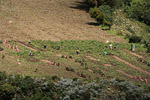 |
Potatoes are the most famous products of the farming in the region. But such cultures as maize and garlic, pineapples and coffee are also grown here.
|
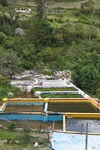 A peculiar sign in shape of a fish is often seen on tourist boards along the highways. This is a sign for the place of fishing: trucha (trout) is abundant in these places. However, one can taste the trucha without possessing a fishing rod: one may say that trucha is the main dish in roadside restaurants, some of them acquired their own fisheries of that fish. Excessive products are sent to different cities of Venezuela and is in great demand.
A peculiar sign in shape of a fish is often seen on tourist boards along the highways. This is a sign for the place of fishing: trucha (trout) is abundant in these places. However, one can taste the trucha without possessing a fishing rod: one may say that trucha is the main dish in roadside restaurants, some of them acquired their own fisheries of that fish. Excessive products are sent to different cities of Venezuela and is in great demand.
|
|
|
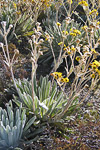 |
Special care is given to unique species of local flora and, first of all, the decoration of mountainous slopes - frailejon espeletia with bright yellow flowers and fluffy leaves that resemble sticking ears of a hare. Frailejon espeletia grows at the height of 3500-4000 meters. It is strictly forbidden to pick them up. They also take special care of rear and vanishing species of fauna, such as Andean condor, mountainous bear, puma and fox, lapa and porcupine, as well as many other little known animals, birds and insects.
|
 |
 |
 |
The main attraction of the Merida state (and partially Barinas) is the National park «Sierra Nevada». The decree on its foundation was published in May 1952. The area of 200 hectars includes mountain chains of La Sierra Nevada de Merida and La Siera de Santo Domingo. There are many rivers and lakes at the territory of the park and Mucubaji and La Canoa are the biggest ones.
|
|
 |
 |
 |
|
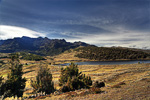 |
 |
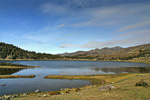 |
|
 |
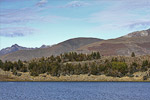 |
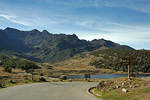 |
|
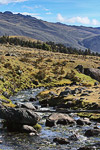
| 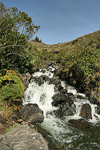
|
Fast river Santo Domingo brings its waters into Orinoco, whereas turbulent Chama – to the lake Maracaibo.
Visiting of the «Sierra Nevada» park is a mandatory ritual for every tourist. There are all conditions for lengthy walks, on foot and on horse, photographic sketches, contacts with nature that was not touched by the claws of neo-liberal civilisation.
|
|
 |
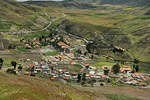 |
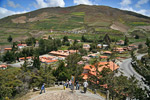 |
The best initial point for introduction to the National park is the town of Apartaderos with its rather good hotels and motels at quite reasonable prices. One of them is “Hotel Parque Turistico “Apartaderos” that attracts tourists attention by its German style, spacious parking and magnificent view of the nearby mountains, valleys, nearby villages and cupolas of astrophysical observatory Llano del Hato. The hotel is situated at the height of 3340 meters above the sea level and that should be kept in mind by those people who came from the plain so that not to make any physical efforts in the first hours of their presence at the high altitude.
|
|
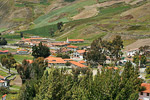 |
 |
 |
|
 |
 |
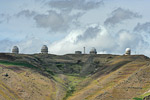 |
|
Hotel Parque Turistico Apartaderos:
 |
 |
 |
The Hotel Parque Turistico “Apartaderos” gives the best European standards services, that is why in the holiday season and red-letter days there are no vacant rooms in the hotel. If you want to get accommodation there – book the rooms in advance.
|
|
 |
 |
 |
|
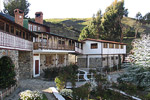 |
 |
 |
|
 |
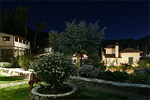 |
 |
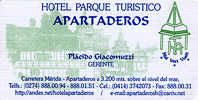 |
|
In the outskirts of Apartaferos there is an original monument, the author of which we failed to find out, of a woman on a hill with her hand stretched to the sky. This is the first in Venezuela literary monument to a heroine of a poem by famous poet Andres Eloy Blanco. In early 30s of the last century the poet was exiled to this region by dictator Gomez. Eloy Blanco was attracted by a local legend about an insane woman Luz Caraballo that lost her all family. He gave a poetic version of sufferings of a woman whose children abandoned her. The poem is carved on the monument.
 |
 |
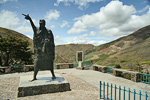 |
Tu hija esta en su serrallo
dos hijos se te murieron
los otros dos se te fueron detras de un hombre a caballos
They say that in capful of wind one can hear the moans of insane Luz. Not far from the monument there is a small shop-museum where you can buy some utensils and delicacies of the region.
|
There are some other interesting routes along the perimeter of Apartaderos.
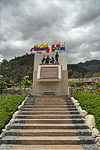 |
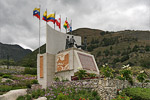 |
In the town of Mucuchies there is another unique monument – to Perro nevado («Snow dog»), that according to the available historic evidence was presented to Simon Bolivar the local residents during his triumph campaign from Colombia to Caracas in 1813. The dog of local breed mucuchies stayed with the Liberator («El Libertador») till 1821 and courageously attacking the royal troops was killed in a famous battle at Carabobo. They say that Simon Bolivar sincerely mourned its loss.
|
|
The monument may seem to someone too pompous and bulky to that extent that the «heroine» is difficult to be seen from the ground just standing at the foot of the monument. But in all cases the monument represents the unanimous love of the Venezuelans to Bolivar. And the probable offsprings of the same «snow dog» are sold by local residents to tourists.
|
 |
 |
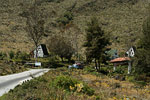 |
 |
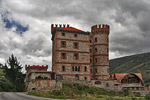 |
Next to the town there is a brick fortress that was constructed by its owner in European style, - San Ignacio. Here there is a hotel and a restaurant.
|
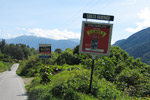 |
 |
Cosy «Alpine» towns San Rafael and Santo Domingo did not stay aside from the boiling political life of Venezuela. Supporters of the Bolivarian revolution, among whom there is a lot of youth, at the days of political manifestations put on red shirts and cachucha caps. In these towns there are many hotels and tourist sites.
|
|
 |
 |
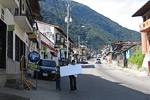 |
 |
 |
 |
Hotel «Santo Domingo» provides all conditions for peaceful rest in maximum comfort. The restaurant of this hotel is famous for its typical «Andean» menu. Mountainous view that is open to guests from their hotel rooms is also unforgettable.
|
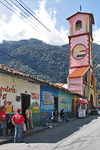 |
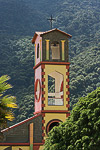 |
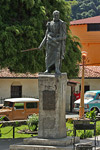 |
In Santo Domingo, founded in 1643, naturally there is a mandatory monument to Simon Bolivar - the Liberator on the central square. The local catholic temple of unique configuration serves as a reference point for tourists. You can't get lost in Santo Domingo. About 2800 citizens live in the town and its outskirts.
Local people speak about their town: «Santo Domingo is a place that is very easy to learn and most difficult to forget». The town is situated at the height of 2180 meters with average temperature of 16 degrees. This is a mountainous heaven with 7 hotels and a dozen of guest houses where one can decently spend a night and have a meal of whatever has been given by the God.
|
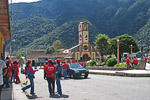 |
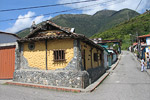 |
 |
The tourist infrastructure in Santo Domingo is impersistent, but effective. The service quality is backed up by kindness and warm-heartedness of dwellers of that area.
|

| 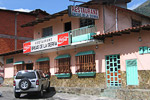
| 
|
We have dropped at the «Brisas de la Sierra» restaurant to have a quick meal.
|
San Rafael:
In the town of San Rafael the main attraction is a church made of stone. It was built by a «folk architect» Juan Felix Sanchez. He alone was building it for several years and passed to the other world with a sense of doing his duty. And lest people forget who made that charming little church, Sanchez erected the monument to himself near the monument to Pope John Paul II.
The state of Merida possesses special charming force. It is just impossible to forget! And when a «haste of cities and streams of cars» becomes totally unbearable, you reach for the map and begin planning a new trip to the region that relieves from stresses and makes you forget the drawbacks of civilisation with its pulse of consumerism, enrichment and success at any cost.

| 
| 
|
Jose Claudio Perez Rivas – is a patriot of his «little motherland» – made a lot for its development and flourishing. However, the monument to him was not erected by grateful countrymen but his relatives. Simply the residents of mountains are thrifty people.
|
|



